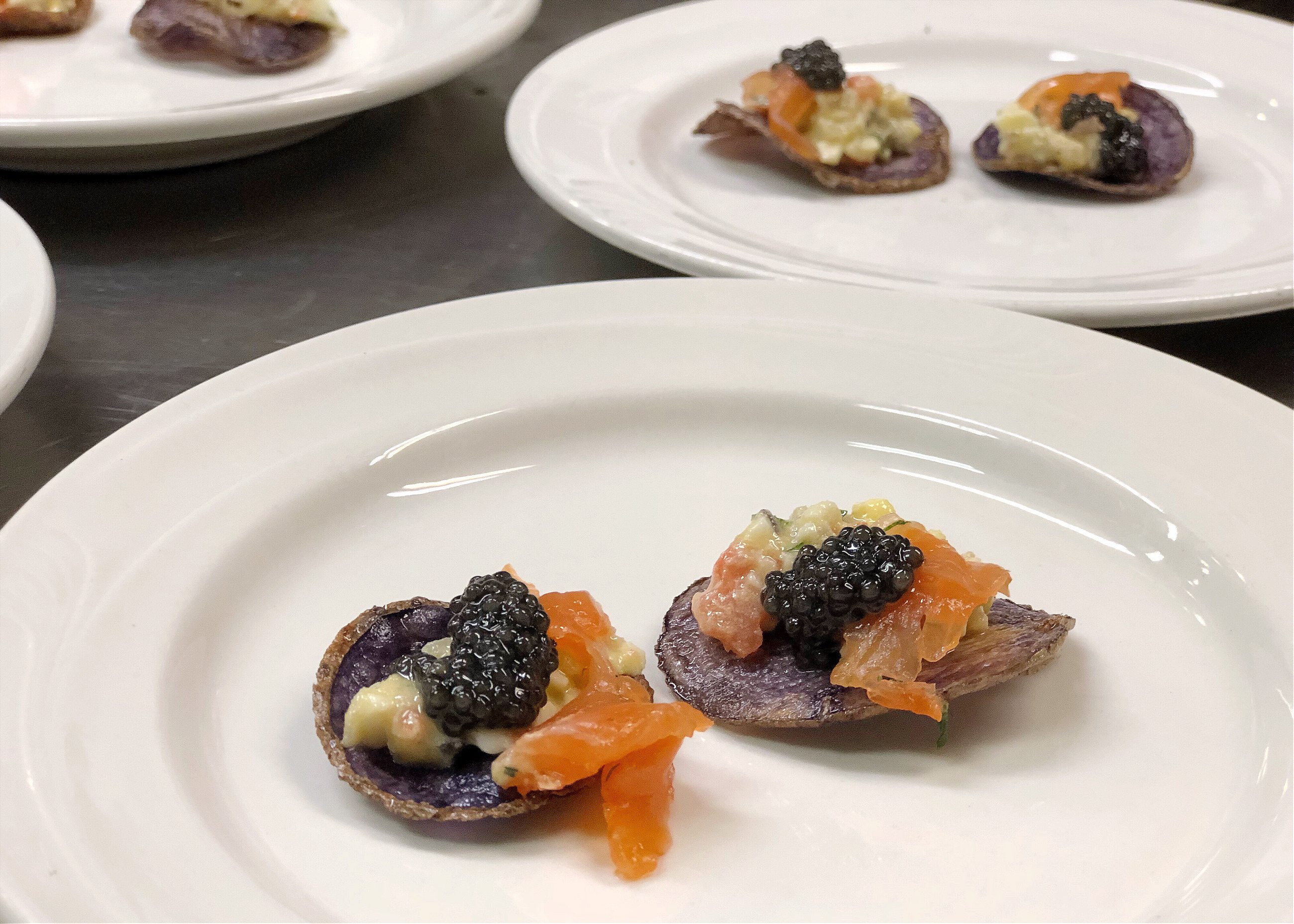A farm in North Carolina is conducting an ambitious experiment in farming sustainable caviar. But will Americans bite?
The chamber inside LaPaz Farm is so clean it almost feels like an operating room. Before we walked into the room, Sabine Mader, the manager of the farm, asks us to put on white coats, gloves and hair nets—and a beard net for my husband. Inside the chamber, a fish cutter is waiting with a freshly dispatched, female Russian sturgeon on the table, one of five to be harvested today. He deftly slices open the fish and pulls back the meat, revealing a wave of grey-black roe in the ovaries. It is the culinary equivalent of an old-fashioned coin purse slit down the middle with a treasure hidden inside. The treasure, in this case, is osetra caviar.
There isn’t much time. A team of two has 30 minutes to weigh, clean, salt, taste, and jar these black pearls before they lose quality. “No one likes mushy caviar,” Mader tells us.
Mader oversees LaPaz farm in Lenoir, North Carolina, set in the Happy Valley region about 90 minutes northwest of Charlotte. Combined with its sister-farm, Marshallberg Farm in Smyrna along the North Carolina coast, LaPaz is the largest source of farm-raised Russian sturgeon in the United States.
In these seemingly modest buildings, an ambitious experiment in sustainability is going on, bowl by bowl of harvested caviar. LaPaz and Marshallberg Farms are striving to show the economics of this business can work, that farming Russian sturgeon now endangered in the wild can be viable—even profitable—in the United States as a sustainable source of caviar.
These farms were set up in response to the troubling trends for wild caviar. Beluga caviar, the coveted gold standard of this luxurious delicacy, has been banned from import into the United States since 2005, because the sturgeon that provide the ever-popular fish eggs are endangered. There is even a ban on fishing Russian sturgeon, the source of osetra, in its natural habitat, the Caspian Sea. Any osetra caviar promoted as “wild” is either from the black market or not really osetra caviar.
Farming in the U.S. has emerged as a possible alternative. But there are many challenges, from questions about animal rights, to the flavor of farm-raised caviar versus wild, to, most notably, whether American farms can raise awareness of the value of homegrown caviar when caviar imported from China is cheaper.
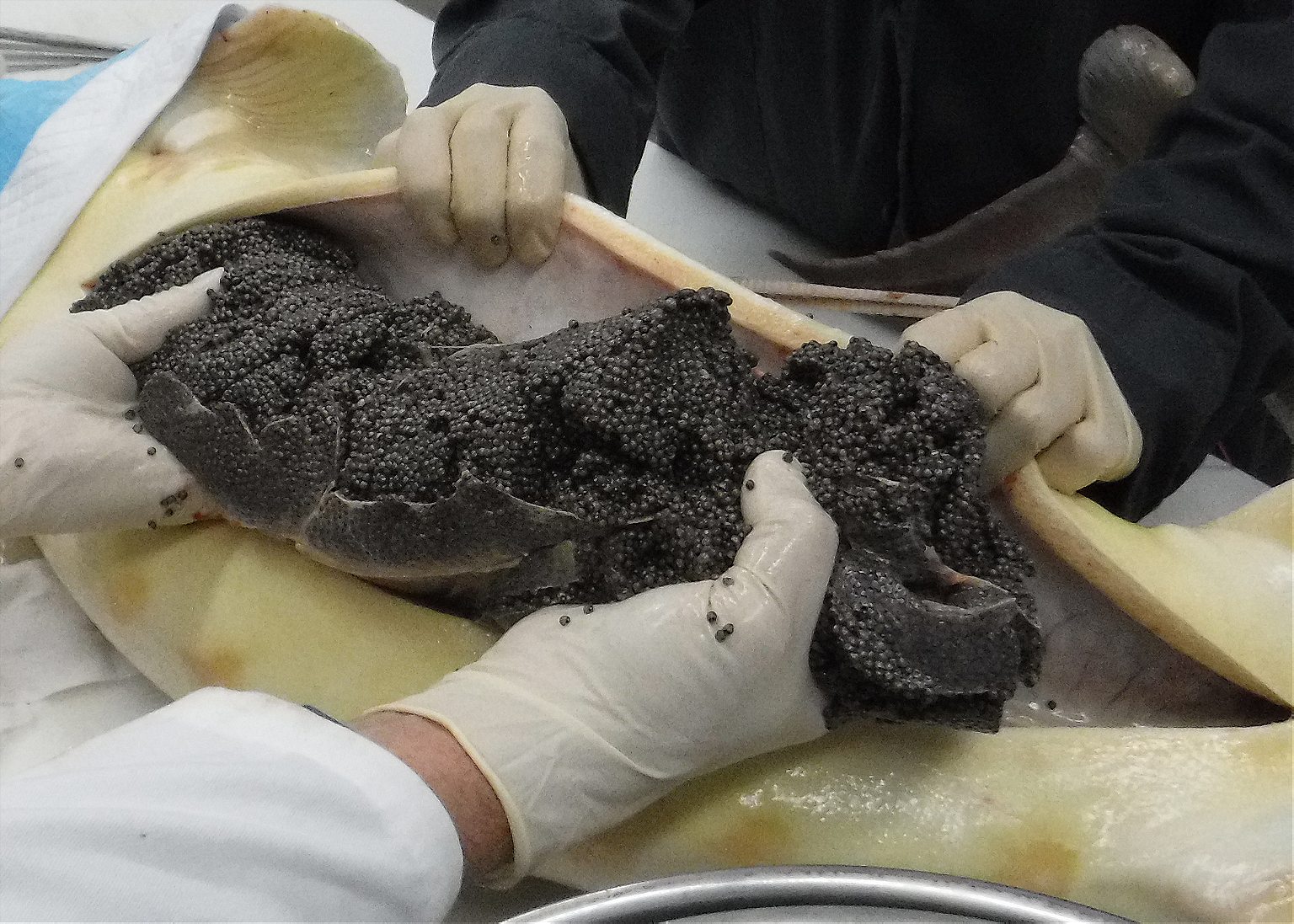
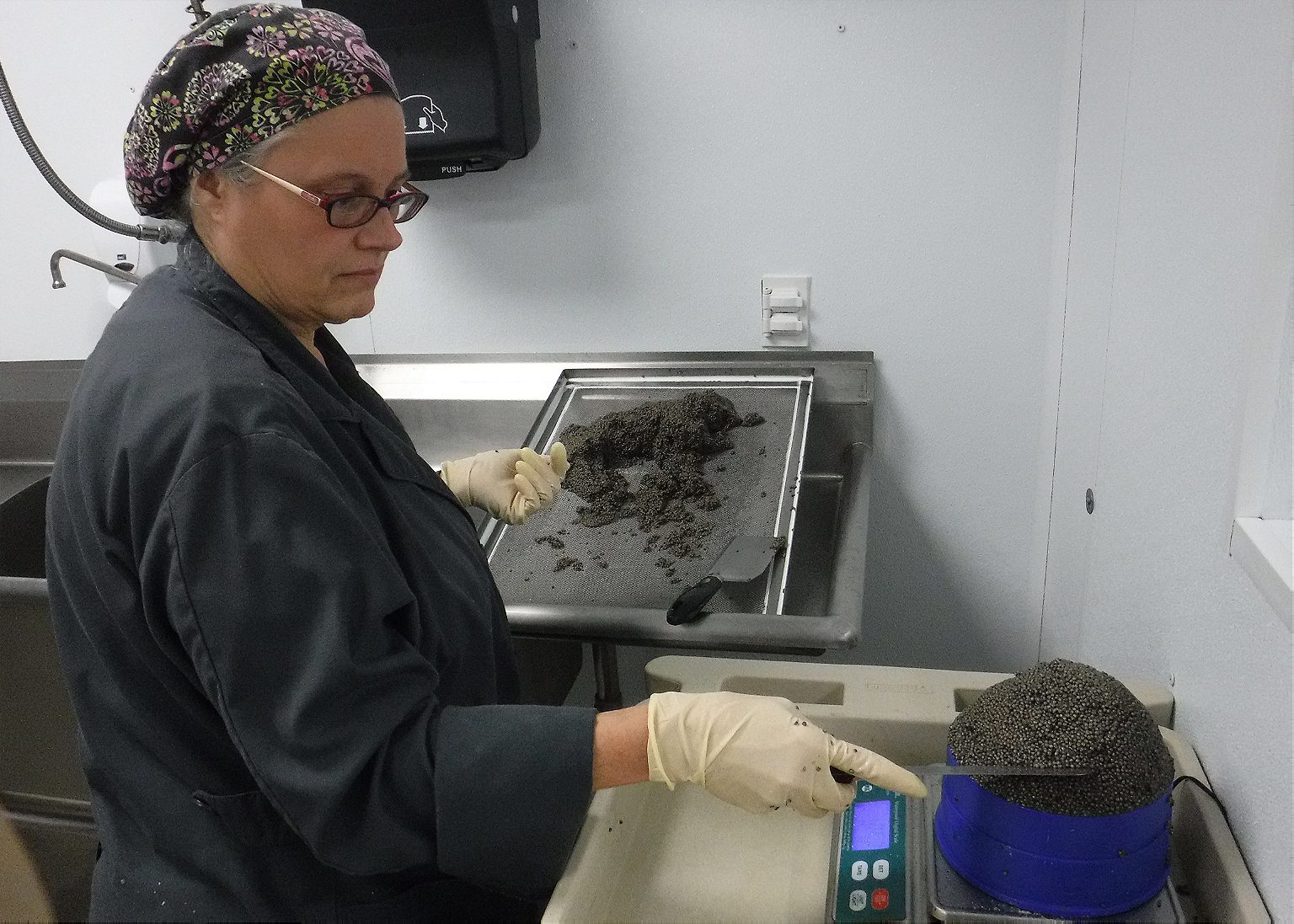
Once the fish cutter lifts the caviar from the fish, the newly harvested eggs get passed through a connecting window to farm veteran Leigh King and her colleague in the processing room, set at a cool 59 degrees to protect the product. They cut the caviar from the pink connective tissue, wash and drain the eggs in large bowls, and smoothen them with a spatula on a slanted mesh sheet as if they were spreading frosting. King hunts and removes sub-par eggs or impurities with a pair of tweezers, repeats the smoothing and hunting, and drains more droplets of water from the caviar onto what looks like an absorbent puppy pad.
“We want the eggs to have a good pop,” Mader, who is also the official taster, says as she scoops out a morsel. It’s her job to track and manage the fish so that the farms spreads harvests evenly throughout the year. If the sturgeon aren’t harvested when ready, the fish can actually start to reabsorb the eggs, which leads to mushy caviar.
Mader demonstrates the eggs’ firmness between her thumb and forefinger, before handing me a bit on a plastic spoon. Unsalted and fresh as caviar can be, it is a beguiling texture that delivers more than a mere flavor. Just as I’m not one to rhapsodize about notes of tobacco, cherries, or whatever in wine, I can’t discern whether these eggs are buttery or have an essence of hazelnut. But once King adds salt—4.25 percent, based on total volume—and Mader gives me another spoonful, I begin to understand what the fuss is about.
Quickly piled into tins that are weighted down to press out excess air, the caviar will continue to absorb salt. Some of it will age one, three or six months and grow nuttier, a character that caviar distributors typically like—and pleasing distributors can be important, given the economics.
LaPaz’s prices on its website range from US$64 to US$93 for a one-ounce tin. An average sturgeon produces one to two kilograms (4.4 pounds) of caviar. A conservative estimate, then, might predict more than US$2,000 in retail caviar sales from a single fish. For now, though, distributors are among the most important customers, and they buy caviar wholesale and resell it to chefs, hotels, and other outlets. In the past, under a previous owner, LaPaz sold its caviar to Lincoln Ristorante at Lincoln Center and the Metropolitan Opera House in New York, among others.
Marshallberg bought LaPaz in 2017 partly because the farms needed their combined strength to have a shot at becoming a profitable business, supplying major distributors, and standing up to the cheaper and far more abundant Chinese product. They hope their gamble—a labor of love in a rarefied industry—will pay off.
“A big challenge is education,” says Lianne Won, who oversees marketing for LaPaz and Marshallberg. “How do you get people to make the step to spend a little more money but be able to say this product is sustainable, not harmful to the environment, and supporting the U.S. economy?” When people dine on caviar, they want to have fun, not analyze, Won adds. “If you go to Las Vegas and order caviar, you aren’t going to ask if it’s sustainable.”
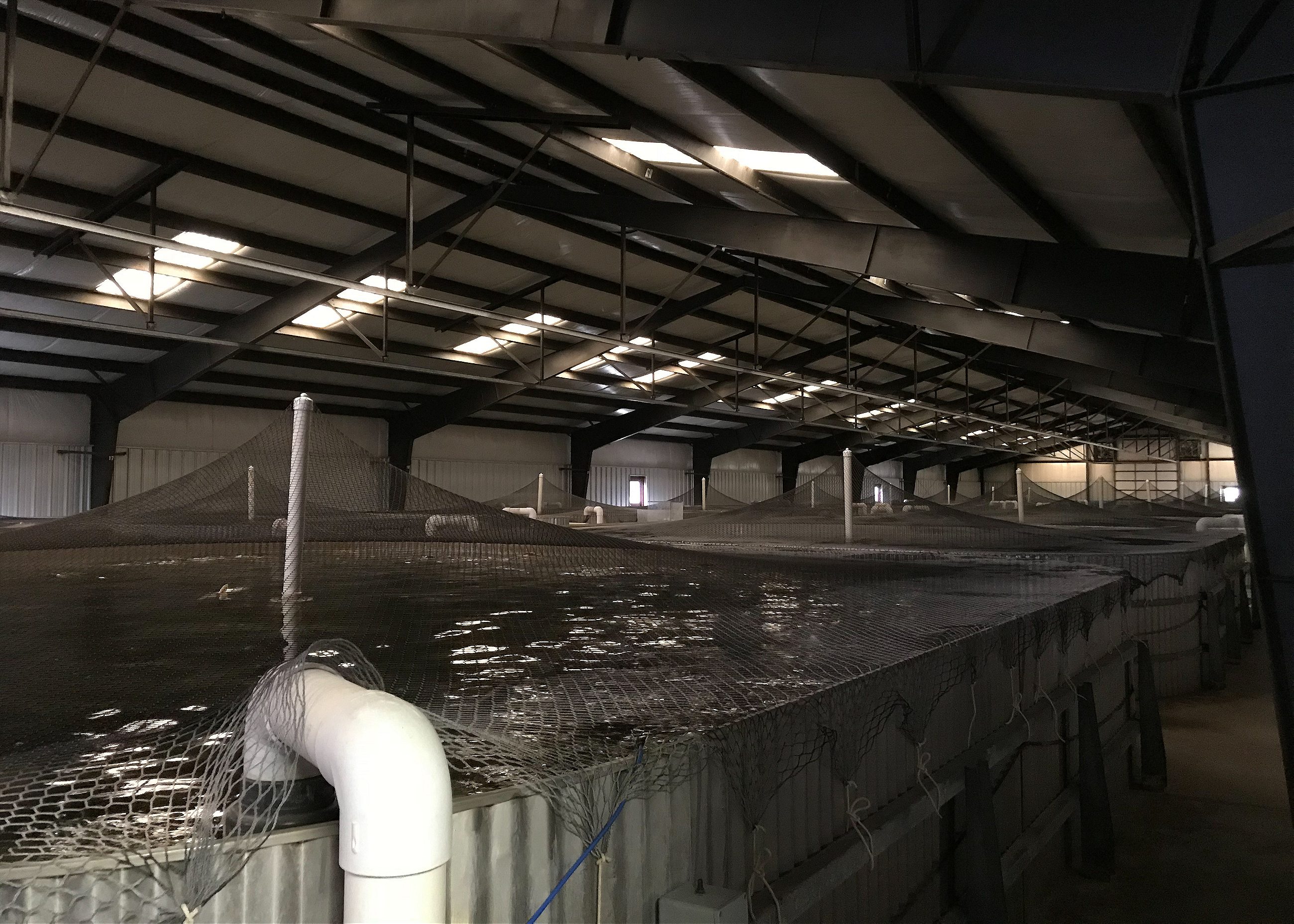
Caviar wasn’t always synonymous with luxury. Sturgeon date to the era of dinosaurs, and with their back ridges called scutes, still bear a resemblance to kids’ dinosaur toys. They were once considered plentiful, according to Inga Saffron, author of Caviar: The Strange History and Uncertain Future of the World’s Most Coveted Delicacy, and their eggs were nothing special.
Most of the world’s caviar during the 19th century came from U.S. waters until sturgeon here began to dwindle, Saffron writes. Then the focus shifted to the Soviet Union, which largely controlled the market in the 20th century. Once the Soviet Union fell apart in 1991, over-fishing in the Caspian Sea and elsewhere accelerated. Lower supply and higher demand in the West led to caviar gaining currency as a symbol of wealth and prestige. Over the last two decades, with wild sturgeon far less plentiful, entrepreneurs have seen the potential and started caviar-farm operations in Israel, France, and Uruguay.
The rise in interest has made caviar a posh ingredient for celebratory meals. And naturally, it invites pretentiousness. President Trump’s Mar-a-Lago resort caused an international uproar earlier this year by serving caviar with plastic, rather than the customary mother-of-pearl spoons. (Mother-of-pearl is presumably better because it’s non-reactive and doesn’t interfere with the caviar’s flavor, like silver would.)
Joe Doll, one of several founders of the Lenoir farm, was a pilot who flew cargo planes to and from Russia (and developed a taste for caviar on these jaunts). He saw firsthand how poaching and overfishing were reducing the numbers of Russian sturgeon. The species has lost more than 70 percent of its spawning grounds in the Caspian Basin in the last seven decades, and in the past 45 years, there’s been a 90 percent decline in the Russian sturgeon population there.
Doll had the engineering skills to help address these trends, including a degree in mechanical engineering, and experience in a family business that invented packing materials. He was involved in the Happy Valley farm’s design, down to the water filtration system; the farm uses 50 gallons of water per minute, much of it cleaned and recycled. Then called Atlantic Caviar & Sturgeon, the farm introduced its first hatchlings into tanks in 2005. “It was just going to be a hobby,” Doll recalls, though the owners’ ambitions eventually grew.
At the coast, I.J. Won, Lianne’s father, a retired NC State University geophysicist and businessman, also worried about the decline in fish stocks. He started building Marshallberg Farm in 2008 to demonstrate that aquaculture can be a sustainable alternative to wild fisheries. Won’s farm merged with the Happy Valley facility in June 2017. “Both companies would have been too small to compete. It’s much better that he has all of it in one business,” says Doll, who is friends with Won.
If you go to Las Vegas and order caviar, you aren’t going to ask if it’s sustainable.
Farming caviar is a painstaking process that takes years. Marshallberg and LaPaz don’t yet breed their own stock; they fly eggs from Germany, hatch them on the coast, then truck, say, a thousand tiny sturgeon at a time to the Happy Valley facility. From there, the fish grow in tanks until they reach from 4 to 5 years old. At that point, “we sex them,” Mader says, or divide the males and females in separate tanks.
To determine if a sturgeon is female, a worker first sedates the fish in a trough with a small electric current. This traditional Russian method of calming the fish is “a really neat way of doing it with minimal invasion to the fish,” Mader says. “You can touch the current with your hands. It doesn’t hurt, just a little tingle.” After that—as hard as it might be to imagine—the fish gets an ultrasound. The images show either testes or ovaries, and if the fish is female, whether she is immature, close to maturation, or ready for harvest. The team takes a biopsy to confirm the quality of the eggs.
Females approaching harvest are placed in separate tanks with fresh, cold water and taken off their feed for four to six weeks. This step mimics what happens in the wild, when sturgeon who migrate to spawning grounds might stop eating for months. It also prevents any muddy or off flavor in the fish or eggs. After that, the fish can be processed. From egg hatching to harvest can take up to eight years; so far, seven years has been typical at LaPaz and Marshallberg.
About 10 to 14 percent of each harvested female sturgeon’s weight is in caviar. The farms produce caviar with only 4.25 percent salt, but as production grows they could tweak salt-levels or the amount of aging to expand their range of products.
Chef Clark Barlowe is a fan of what they’re selling. At Heirloom, his Charlotte restaurant, he initially served the caviar atop deviled eggs and in a traditional Russian style with bellini and accompaniments. Since then, he’s played with unexpected dishes such as shrimp and caviar grits, with caviar folded in just before serving. He likes to use the fresh sturgeon, too. Sturgeon is fatty—“salmon on steroids in terms of the fat content”—which lends itself to pan-roasting and, also, to making bacon. Barlow recently cured the fish meat for six days in a blend of salt, sugar, spices, and wild crinkle-root, then smoked it with applewood, sliced it, and baked it.
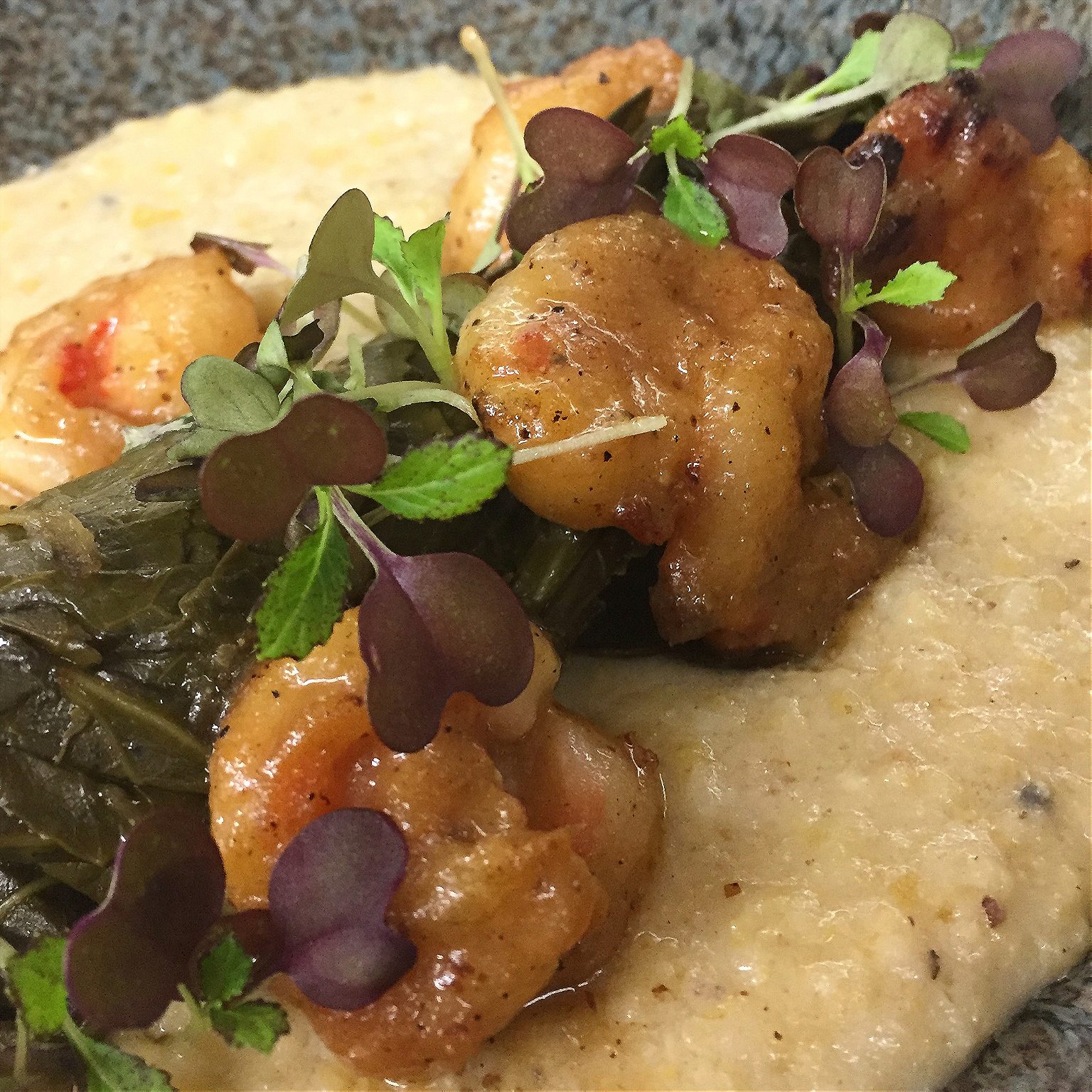
LaPaz and Marshallberg are the only Russian sturgeon outfits that together have the capacity to produce up to five tons a year. Just a few other small U.S. farms are raising Russian sturgeon. Most Americans haven’t tasted the fish yet, and Barlowe has found the caviar comparable, if not better, to others he’s sampled. He especially likes the dark shade of caviar from LaPaz and Marshallberg: “I would put that up against any caviar anywhere in the world.”
Raising 40,000 to 60,000 of these fish at any given moment takes a lot of effort, and like small businesses in many industries, the two farms face price pressures from less expensive imports, Mader says, taking a bite of fish.
The top threat is China, which currently produces about 35 percent of the world’s supply of caviar and is getting media buzz for its Kaluga Queen brand. Kaluga says it sells 60 tons of caviar annually, compared to the single-ton Mader says the farms may harvest this year, although production could be higher depending on demand.
“As far as our sales go, China is a big challenge,” Won says. Chinese-farmed osetra caviar, imported into the U.S., can sell for as low as US$350 a kilogram (2.2 pounds) wholesale. That price appeals to caviar distributors, the middlemen who in turn sell to restaurants. “We have to sell our product a lot higher than that,” Won says, because of the greater expenses of operating the farms in the U.S.
Costs are also higher here. LaPaz and Marshallberg pay U.S. wages and produce edible commodities in accordance with U.S. regulatory standards. When distributors try to negotiate the price down, Mader reminds them that China’s track record with safety isn’t pristine.
“The quality is probably not as good. We don’t know what’s in it—antibiotics, hormones, chemicals? The regulations aren’t as tough as in the U.S.” Some Chinese producers may use Borax to preserve their caviar, the same substance, I realize, that I have sprinkled under the couch to get rid of fleas my dog brought in.
Mader also cites a controversy that some sturgeon in China may secretly be hybrids rather than pure Russian sturgeon with osetra eggs. Her goal is to work with distributors who value and support the farms as an American business. (The farms are currently negotiating with a major international distributor to carry their caviar.) Ultimately, the goal is 20 percent of sales to chefs and individual shoppers via the website, and 80 percent to distributors.

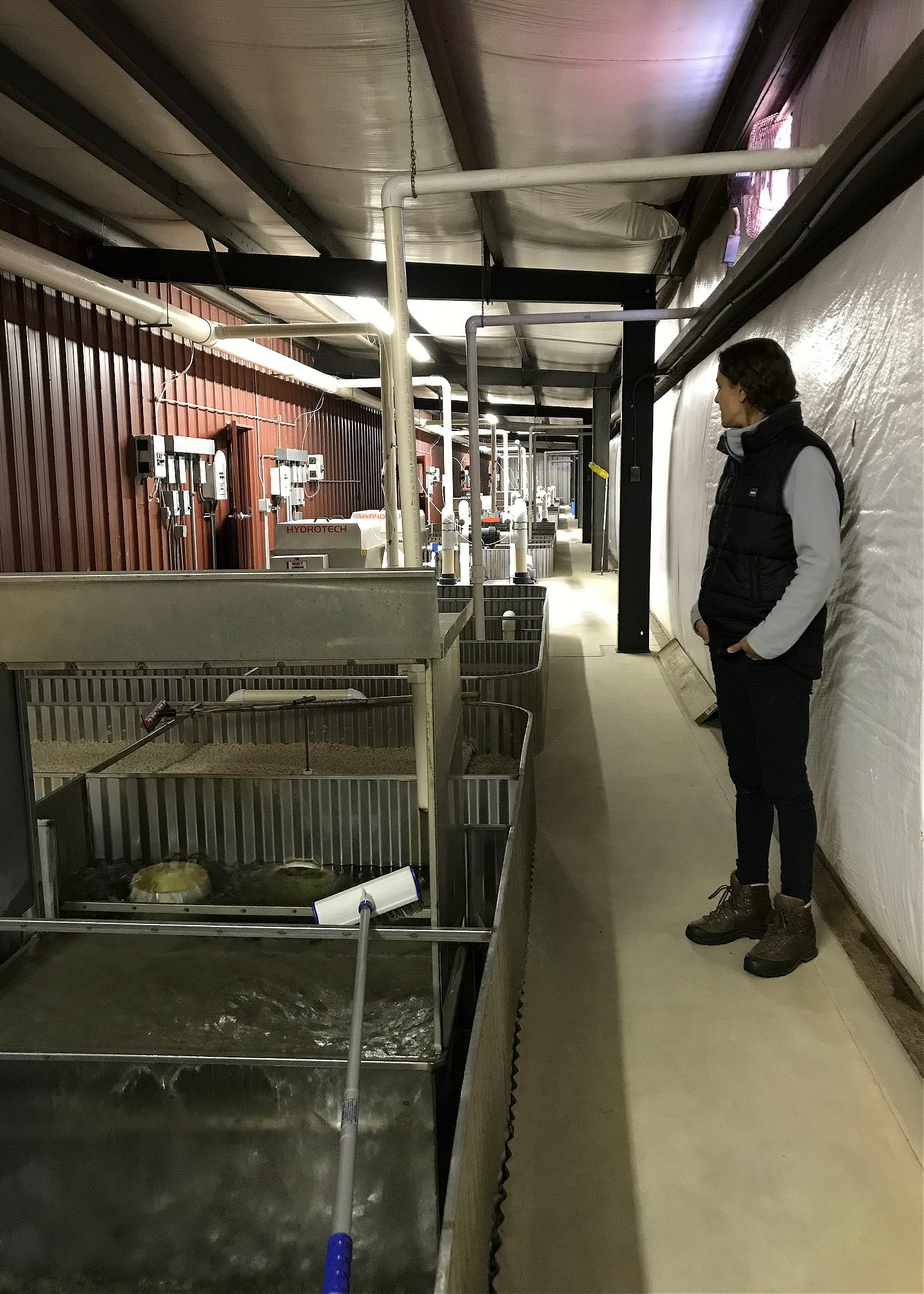
In recent years, some people have disputed the idea that sturgeon can be farmed humanely. In January 2018, Scottish actor Alan Cumming urged Argyll and Bute Council, a local authority that administers part of Scotland’s southwestern coast and its various islands, to reject plans for Scotland’s first caviar farm at Loch Fyne, a lake already renowned for its oysters and shellfish, and a restaurant on its shore that spawned a successful British seafood chain. (The plans have since been approved.) Cumming is a proponent of vegan caviar made from seaweed as a replacement (he sent the Council some of this alternative as part of his protest).
PETA (People for the Ethical Treatment of Animals) has been an active opponent of aquaculture farms, arguing that the fish lead miserable lives in “severely crowded tanks,” where they “have no option but to swim in endless circles.” The overcrowding and unnatural conditions, PETA charges, makes the fish highly susceptible to stress and aggression.
Won, for her part, says her sturgeon would die if they didn’t have adequate space; she’s proud of the care they receive. “Americans farm everything else. We farm cattle, pigs, chicken. Why are we taking fish from the ocean when we can be farming that, too?”
